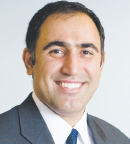It is a difficult task to include every notable presentation from the 2017 American Society of Hematology (ASH) Annual Meeting & Exposition. In addition to our more comprehensive coverage of the news from that meeting over the past several issues, below are summaries of additional key presentations related to multiple myeloma and acute myeloid leukemia that we hope you will find of interest.
Daratumumab for Smoldering Multiple Myeloma
Single-agent daratumumab (Darzalex) showed activity in intermediate- and high-risk smoldering multiple myeloma in a study presented by Craig Hofmeister, MD, MPH, of Winship Cancer Institute of Emory University.1 Treatment with daratumumab, especially for up to 20 cycles, resulted in delays in progressive disease.

Fewer patients [had disease progression with daratumumab] on the long and intermediate [dosing schedule] arms.— Craig Hofmeister, MD, MPH
Tweet this quote
The phase II CENTAURUS trial randomized 123 patients to treatment with daratumumab at 16 mg/kg in 8-week cycles, under various dosing schedules. In the long-intense dosing schedule, daratumumab was given weekly in cycle 1, every other week in cycles 2 to 3, every 4 weeks in cycles 4 to 7, and every 8 weeks thereafter up to cycle 20. In the intermediate dosing schedule, the drug was given weekly in cycle 1 and every 8 weeks up to cycle 20. In the short-intense dosing schedule, it was given weekly for one cycle.
The overall response rates were 56% for the long-intense treatment arm, 54% for the intermediate arm, and 38% for the short-intense arm; complete responses were achieved by 2%, 5%, and 0%, respectively. The 12-month progression-free survival rates were 95%, 88%, and 81%, respectively. Post hoc analysis comparing the long-intense and intermediate arms, vs the short-intense arm, yielded a P value of .0398.
“The coprimary endpoint of complete response rate more than 15% was not met, but the coprimary endpoint of median progression-free survival of at least 24 months was met,” Dr. Hofmeister said. “Fewer patients [had disease progression] on the long and intermediate arms.” The authors concluded that efficacy and safety were best with the long dosing schedule, which will be evaluated in a phase III study.
Conditioning With Busulfan Plus Melphalan
In a randomized phase III trial of two conditioning regimens prior to transplant in multiple myeloma patients, researchers from The University of Texas MD Anderson Cancer Center, Houston, showed that the combination of busulfan and melphalan significantly prolonged progression-free survival over melphalan alone.2
The study’s 204 patients were randomized to standard-of-care melphalan at 200 mg/m2 or to busulfan/melphalan. In the combination arm, busulfan at 130 mg/m2 was infused daily for 4 days, followed by two daily doses of melphalan at 70 mg/ m2. Melphalan at 200 mg/m2 was given as a single dose in the -melphalan-only arm.

Muzaffar H. Qazilbash, MD
At 100 days, the nonrelapse mortality rate was 0% in both arms, and at 1 year, it was 2% with busulfan/melphalan vs 0% with melphalan alone. The combination was associated with significantly more grade 1–3 mucositis, -neutropenic fever and elevations of alanine aminotransferase.
At 28 months’ median follow-up, most outcomes were similar between the arms, but median progression-free survival was significantly improved with busulfan/melphalan: 64 months vs 36 months for melphalan alone (P = .013). “We continued to see a significant difference in progression-free survival after adjusting for the type of maintenance therapy used in each arm,” said Muzaffar H. Qazilbash, MD.
The combination also significantly increased progression-free survival in the high-risk subgroup (P = .021). There were no significant differences in the rates of complete remission, minimal residual disease negativity, very good partial responses, nonrelapse mortality, or overall survival.
Two vs Three Cycles of Consolidation Therapy in AML
In acute myeloid leukemia (AML) patients with favorable-risk cytogenetics, two cycles of consolidation therapy were associated with similar overall survival and relapse-free survival rates compared to patients intended for three cycles.3 These data were from a retrospective analysis across provinces in Canada.

Daniel Sawler, MD, BSc
Core-binding factor AML is deemed a favorable-risk disease. Current recommended treatment is with standard anthracycline and cytarabine–based induction followed by cytarabine-based consolidation chemotherapy without allogeneic stem cell transplant, unless a C-KIT D816V mutation is present.
No previous study has compared two vs three cycles of consolidation chemotherapy in patients with core-binding factor AML, said Daniel Sawler, MD, BSc, hematology resident at the University of Alberta, Canada, who is the first author of the retrospective study. The study included 108 newly diagnosed patients with core-binding factor AML intended for 2 cycles (34 patients) or 3 cycles (74 patients) of consolidation chemotherapy; cohorts were from Edmonton, Alberta, and Vancouver, with data from 2003 to 2017.
MORE FROM ASH ON ASCOPOST.COM
For comprehensive coverage of the 2017 ASH Annual Meeting & Exposition, including news reports on trial results, expert perspectives on practice-changing findings, and video interviews with hematology opinion leaders, visit www.ascopost.com/
+ASH+Annual+Meeting.
No significant differences in complications were observed between the two groups, including hospitalizations, ICU admissions, bacteremic events, and deaths.
Patients who got two cycles had longer follow-up: median of 85 months vs 30 months, respectively (P < .0001). Numerically more patients received transplants in first complete response in the two-cycle group: 18% vs 7% (P = .09). The relapse rate was no different between groups. More patients in the three-cycle group were transplanted after relapse: 19 patients vs 3 patients in the two-cycle group (P = .04). No significant difference in deaths was reported.
The 5-year overall survival rate was 73% for the two-cycle group and 71% for the three-cycle group. The 5-year relapse-free survival rate was 63% and 57%, respectively.
The authors plan further studies, including a randomized trial to compare two vs three cycles of consolidation chemotherapy.
Targeted Therapies: Ivosidenib
In a phase I study, ivosidenib (AG-120) induced complete response or complete response with partial hematologic recovery in 30.4% of patients with relapsed or refractory IDH1-mutant AML.4 In this group of 125 patients (92 dose-expansion phase, 33 dose-escalation cohort), the objective response rate with single-agent ivosidenib at 500 mg/d was 41.6%, with a median duration of response of 6.5 months. Median duration of complete response or complete response with partial hematologic recovery was 8.2 months. Among patients in complete response, the rate of minimal residual disease negativity was 28%.

In all patients with relapsed or refractory AML, most of whom had received multiple prior AML treatments, ivosidenib induced durable responses.— Courtney D. DiNardo, MD
Tweet this quote
“In the patients with relapsed or refractory AML, most of whom had received multiple prior AML treatments and were without effective therapeutic options, ivosidenib induced durable responses. Additionally, the patients who attained a molecular minimal residual disease–negative complete response had improved overall survival compared to the relapsed/refractory AML patients with persistent minimal residual disease,” said lead author Courtney D. DiNardo, MD, of The University of Texas MD Anderson Cancer Center.
No platelet transfusions were required in patients who had a complete response, and 84.6% were red blood cell–transfusion independent. All responding patients had a lower incidence of febrile neutropenia and infections.
The phase III AGILE trial is now evaluating ivosidenib plus azacitidine compared with placebo plus azacitidine for untreated patients with IDH1-mutant AML.
Targeted Therapies: Gilteritinib
A separate phase I dose-escalation/dose-expansion study found that gilteritinib combined with intensive chemotherapy was well tolerated, with high response rates in FLT3 mutation–positive, newly diagnosed AML patients.5 The study enrolled 50 patients (17 in the dose-escalation cohort; 33 in the dose-expansion cohort). Of them, 48 had known FLT3 mutation status; 23 (47.9%) had FLT3-mutated AML, of whom 15 (65.2%) had internal tandem duplications (FLT3-ITD).
Dose-limiting toxicities included neutropenia, thrombocytopenia, and decreased ejection fraction. The maximum tolerated dose was 120 mg/d.

Keith Pratz, MD

Amir T. Fathi, MD
The end-of-treatment investigator-reported composite complete remission rate was 71.4%, and 57.1% achieved complete response. End-of-treatment composite complete remission rates were 91.3% for patients with FLT-mutated AML and 56% for those with FLT-negative disease. Median progression-free survival and duration of response have not yet been reached.
The lead author of the study was Keith Pratz, MD, of Johns Hopkins University, Baltimore.
“Therapies targeting IDH and FLT3 proteins are highly promising, and the take-home message is that targeted therapy in AML is an emerging therapeutic paradigm, as monotherapy and now in combination with conventional approaches,” stated Amir T. Fathi, MD, Director of the Leukemia Program, Massachusetts General Hospital, Boston, who singled out these two abstracts as noteworthy. ■
DISCLOSURE: Drs. Hofmeister, Qazilbash, Sawler, and Pratz reported no conflicts of interest. Dr. DiNardo is on the advisory board of Agios, Celgene, and Bayer. Dr. Fathi has been a consultant for Celgene and has been on the advisory board of Agios and Astellas.
REFERENCES
1. Hofmeister, CC, Chari A, Cohen Y, et al: Daratumumab monotherapy for patients with intermediate or high-risk smoldering multiple myeloma. 2017 ASH Annual Meeting & Exposition. Abstract 510. Presented December 10, 2017.
2. Qazilbash MH, Bashir Q, Thall PF, et al: A randomized phase III trial of busulfan + melphalan vs melphalan alone for multiple myeloma. 2017 ASH Annual Meeting & Exposition. Abstract 399. Presented December 10, 2017.
3. Sawler D, Sanford D, Hogge D, et al: Two cycles of consolidation chemotherapy are associated with similar clinical outcomes to three cycles in AML patients with favorable risk cytogenetics. 2017 ASH Annual Meeting & Exposition. Abstract 464. Presented December 10, 2017.
4. DiNardo CD, DeBotton S, Stein EM, et al: Ivosidenib (AG-120) in mutant IDH1 AML and advanced hematologic malignancies. 2017 ASH Annual Meeting & Exposition. Abstract 725. Presented December 11, 2017.
5. Pratz K, Cherry M, Altman JK, et al: Preliminary results from a phase I study of gilteritinib in combination with induction and consolidation chemotherapy in subjects with newly diagnosed acute myeloid leukemia. 2017 ASH Annual Meeting & Exposition. Abstract 722. Presented December 11, 2017.

